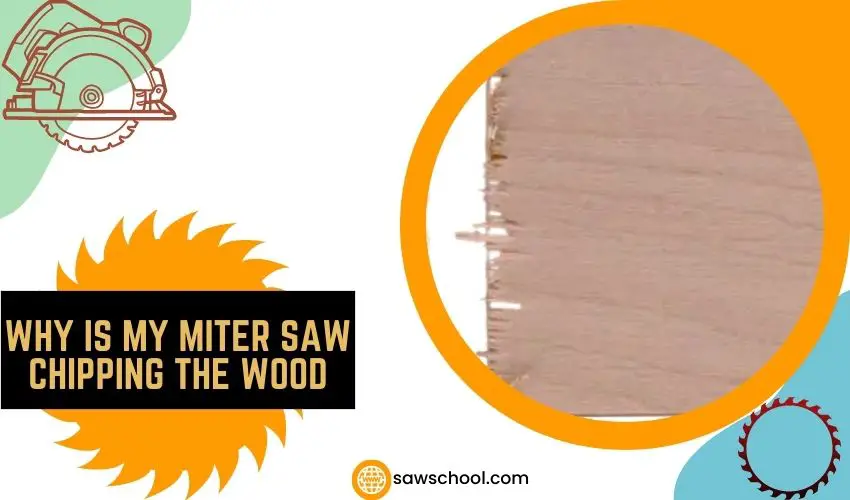Nothing is more frustrating than completing a cut with your miter saw only to find out that the piece is ruined because of chipping. If this is a common occurrence that you experience with your miter saw, it’s time to look for reasons. It’s time to ask yourself, why is my miter saw chipping the wood and what can I do about it?
You might be using the wrong blade type or a dull blade. Some other reasons that cause miter saws to chip wood are a wide insert, a dirty blade, misalignment with the fence, etc.
To learn more details about the probable reasons and solutions to this issue, make sure to read the full article.

Why Is My Miter Saw Chipping The Wood? [6 Common Reason Behind Chipping]
There can be several reasons why your miter saw might be chipping wood. I’ve discussed the most significant reasons to look for below.
Wrong Blade
You might be using the wrong blade for cutting the material. There are a variety of blade types available suitable for different material types and different cuts. For instance, if you are going for crosscuts, the blade will be different than the blade you would use for rip cuts.
Teeth count has a significant value in determining what blade is suitable for your specific material. If you want to learn more about blades with different teeth counts, you can check my article on 60 vs 80 vs 100 tooth miter saw blade.
Dirty Blade
One of the common reasons why your wood might be chipping is that you have a dirty blade. Over time, when you’ve used the blade for quite some time, residue can build up on the blade, interfering with the material when you are cutting.
Dull Blade
Another blade-related issue that causes wood to chip is dullness. The blade should always be sharp if you are expecting clean cuts. After using the blade for some time, it can get blunt. A dull blade can’t cut wood with as much efficiency as a sharp blade, which often results in chipping.
Wide Insert
If your miter saw kerf is wide, it reduces the support below the wood, causing the wood to chip. It’s one of the minor reasons that are not directly related to the blade. So, if there’s nothing wrong with your miter saw blade, it’s time to check the kerf.
Misalignment
Sometimes when the fence is not properly aligned, the wood doesn’t get enough support required for a clean cut. So, make sure to check everything before you start cutting the material with your miter saw.
Bumpy Surface
Another reason your wood might be chipping is due to an uneven surface. If the tabletop is bumpy and the miter saw wobbles, it can cause the material to chip.
How To Prevent My Miter Saw From Chipping Wood?
Considering the major reasons that cause miter saws to chip wood, you can avoid chipping by fixing these issues. Let’s take a look at how you can do that.
Use The Right Blade
Finding the correct blade for the specific material you are cutting is essential. When cutting hardwood, you won’t need a high tooth count. However, if you are going for crosscuts, it’s better to choose a blade with a higher tooth count. Note that if you are cutting MDF boards, you will need a very high tooth count compared to when you are cutting hardwood.
The material of the blade also has an impact on clean cuts. You can go for a carbide blade to stay on the safe side. You can also choose carbide-tipped blades that are made of steel.
Use A Clean Blade
The blade you are using must be clean. If the chipping problem emerged out of nowhere, the reason might be a dirty blade. To make sure that your miter saw doesn’t lose the touch of perfection, it’s better to clean the blade every now and then.
If you don’t know how to properly clean your miter saw blade, let me give you one easy way. Take a container big enough to fit and clean the blade. Now, pour the No products found. into the container and soak the blade for about twenty minutes.
Use a brush to get rid of the debris from the blade and wipe it off with a clean cloth.The blade is now ready for your miter saw.
Use A Sharp Blade
Sharpness is one of the mandatory elements if you want your blade to cut wood without chipping. So, investing in a high-quality blade is a smart solution because it will hold the sharpness for a longer period.
If you have been using the blade for quite some time and the blade now requires more force than before to cut through materials, it can be a sign of dullness. You can either sharpen the blade or invest in a new one if you want to avoid chipping in the future.
Zero Clearance Kerf
Reducing the gap of your kerf can decrease the chance of chipping. So, the best thing to do in this case is to get a zero clearance kerf. The good news is, you can make one all by yourself. However, if you don’t want to make one, there are plenty of affordable options you can go for.
A Few Other Tricks To Avoid Chipping
- Always make sure that you are setting your miter saw on top of an even surface. It shouldn’t wobble.
- You can tape the material over the cutting line. It can reduce chipping for almost all materials.
- Don’t put too much pressure while cutting the material. The blade should spin fast enough to cut through the material without too much effort.
- Make sure that the material has enough support from the fence and the miter saw. If it doesn’t sit properly, the wood may chip.
- Allow the blade to reach its fullest speed before making contact between the blade and the material.
Safety Tips
- Do not use the miter saw while keeping it on the ground.
- Avoid cutting small pieces with your miter saw. The pieces should not be smaller than eight inches if you want to avoid accidents.
- Keep your hands away from the spinning blade.
- Make sure that the blade guard is always in place when you’re working with your miter saw.
- Keep unnecessary materials out of the way when working with a particular workpiece.
Frequently Asked Questions

How do you smooth wood after cutting?
The edges of your workpieces can still be rough after going through a smooth miter saw cut. If you require a higher level of smoothness, you can use fine-grit paper to smoothen the cut.
How many teeth should a miter saw blade have?
Tooth count depends on the material you’re cutting and the type of cut you are going for. Hardwood doesn’t require a high tooth count. However, if you are going for crosscuts, it’s best to go for a blade that at least has an 80 tooth count.
A higher tooth count ensures a smooth cut and prevents the material from chipping. Nonetheless, a blade with a low tooth count is handy when you want the cut to be fast.
Final Words
Hopefully, after following what I’ve suggested in this article, you won’t have to ask again why is my miter saw chipping the wood. The problem is sometimes as simple as a dull blade. And sometimes, it can require going for multiple fixes.
Note that the way you use your miter saw is also responsible for making clean and smooth cuts. So, if this is your first time using a miter saw, make sure to allow enough time to understand your tool better. The more you cut materials with your miter saw, the more you will get comfortable with it. With time, the cuts will get cleaner.
